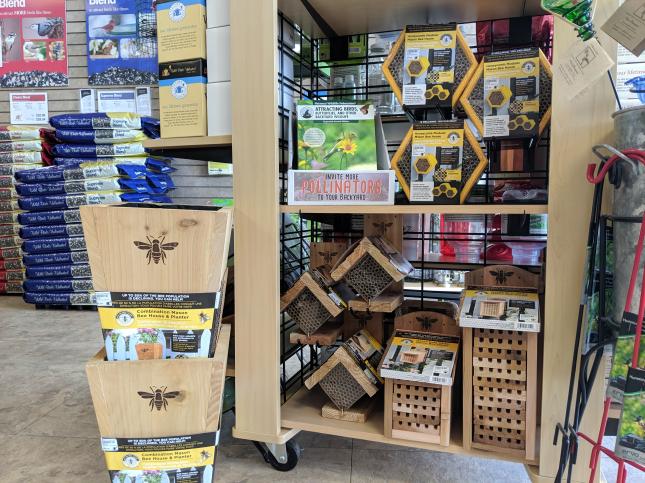Learn about Pollinators
Did you know that about one third of all our food sources, especially grains, fruits and vegetables, exist because of pollinators? Unfortunately, loss of habitat and native food sources is leading to a serious decrease in many pollinator populations. Pollinators need your help through creating awareness of this issue and establishing a pollinator-friendly habitat in your yard to help pollinators survive and flourish.
When we think about pollinators, bees quickly come to mind. Did you know that birds, bats, butterflies, moths, flies, beetles, wasps, and even small mammals are also pollinators? Pollinator populations are shrinking and shifting due to pollution, misuse of chemicals, disease, and the effects of climate change. Would you like to know more? Good websites are Pollinator Partnership https://www.pollinator.org/pollinators and the U.S. Fish and Wildlife Service https://www.fws.gov/pollinators/Index.html.
One of the greatest pollinator is the Mason Bee. Learn more about this species of bee and how you can help them thrive.
About Mason Bees
• Mason bees are not aggressive towards people. They only sting as a last resort, and the venom is very mild. You
can watch them work without fear of being stung.
• Mason bees are known for being amazing pollinators, especially for fruit trees, such as apples, pears and peaches.
Increasingly, they are being reared commercially, especially for fruit crop pollination. This has led to them to also be
known as orchard bees.
• The mason bee is also a very productive pollinator for spring flowering nut trees, flowering shrubs and spring berry
plants. Mason bees are also generalists that love to visit a wide variety of early blooming flowers.
• Mason bees don’t make honey. But they do make it possible for plants to create seeds and reproduce, for fruit trees
and berry plants to increase their production, and for wildflowers to grace our landscape every year.
• Unlike honey bees, mason bees carry pollen on their bellies rather than on their hind legs, this helps to make them
highly efficient pollinators. A single mason bee will visit between 1,600 to 2,400 blossoms daily, and pollinate over
90% of them. A female visits an average of 75 flowers per foraging trip.
• Successful pollination using mason bees does not require a large population of bees. Backyard orchards of a few
dozen trees may be effectively pollinated with 50 female bees or less.
• Mason bees are tunnel-nesting, solitary bees, which means that unlike the honeybee, every female is a “queen”
who builds her own nest, gathers her own food, and lays her own eggs…all without any help from other bees.
• Although mason bees are solitary, they are often gregarious and will nest near other mason bees.
• Mason bees lay their eggs in tunnel nests that are constructed in abandoned holes created by wood-boring insects,
hollow plant stems or artificial houses and tubes.
• When building their nests, female mason bees use clay to build partitions and to seal the tunnel entrance. This
unique mud-building behavior is what led to the name “mason” bee.
Be a Mason Bee Landlord:
• Mason bees are among the easiest bees to raise, while also being the safest due to their gentle nature.
• Artificial houses provide a very acceptable nesting location for the female mason bees.
• The optimal location to hang a mason bee house is 6 to 7 feet off the ground with the entrance holes facing towards
the east or southeast, preferably under an eave of your house, garage, shed or any other structure that will not
shake in the wind.
• Mason bees only fly about 300’ in search of nectar and pollen, so place the house near your flowering plants and
trees.
• Birds and bees don’t always mix, so try not to install your bee house too close to any birdhouses and feeders. If
your feeders are in the backyard, consider placing your bee house in the front or side yard and out of sight of birds
visiting the feeders.
• Offer a plant tray of moist clay or keep a wet patch of bare soil within 25’ of the mason bee house, this will provide a
quick and attractive source for them to use while constructing their brood cells.



